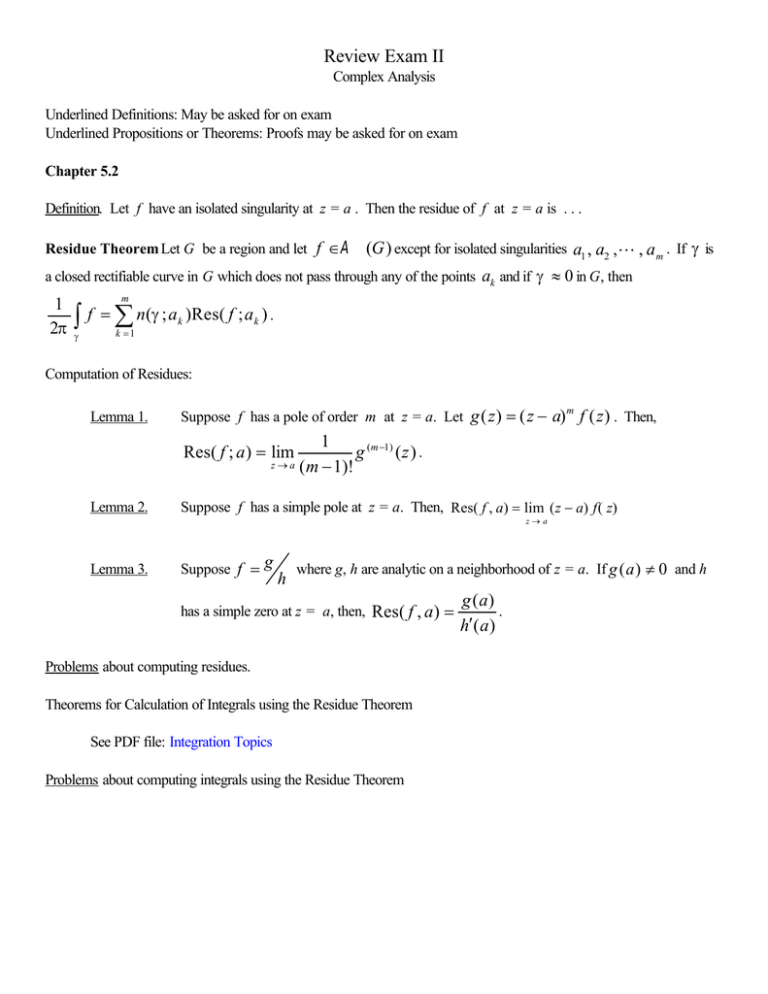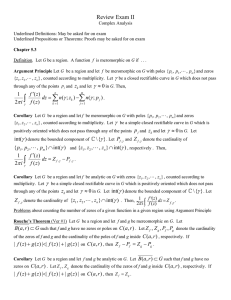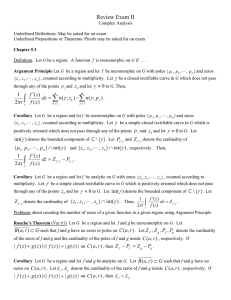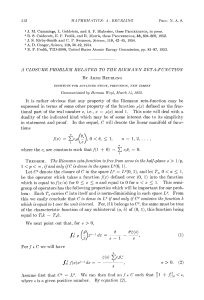Review Exam II
advertisement

Review Exam II
Complex Analysis
Underlined Definitions: May be asked for on exam
Underlined Propositions or Theorems: Proofs may be asked for on exam
Chapter 5.2
Definition. Let f have an isolated singularity at z = a . Then the residue of f at z = a is . . .
Residue Theorem Let G be a region and let f ∈A (G ) except for isolated singularities a1 , a2 ,L , a m . If γ is
a closed rectifiable curve in G which does not pass through any of the points ak and if γ ≈ 0 in G, then
1
2π
∫
γ
m
f = ∑ n (γ ; a k )Res( f ; a k ) .
k =1
Computation of Residues:
Lemma 1.
Suppose f has a pole of order m at z = a. Let g ( z ) = ( z − a) m f ( z ) . Then,
1
g (m −1) ( z ) .
z → a ( m − 1)!
Res( f ; a) = lim
Lemma 2.
Suppose f has a simple pole at z = a. Then, Res( f , a) = lim ( z − a) f ( z)
z→a
Lemma 3.
Suppose f = g
h
where g, h are analytic on a neighborhood of z = a. If g ( a ) ≠ 0 and h
has a simple zero at z = a, then, Res( f , a) =
Problems about computing residues.
Theorems for Calculation of Integrals using the Residue Theorem
See PDF file: Integration Topics
Problems about computing integrals using the Residue Theorem
g (a)
.
h′( a)
Chapter 5.3
Definition. Let G be a region. A function f is meromorphic on G if . . .
Argument Principle Let G be a region and let f be meromorphic on G with poles {p1, p2 ,L , pm } and zeros
{z1, z2 ,L, zn} , counted according to multiplicity. Let γ be a closed rectifiable curve in G which does not pass
n
m
1
f ′( z )
through any of the points p j and z k and let γ ≈ 0 in G. Then,
dz = ∑ n(γ ; zk ) − ∑ n (γ ; p j ) .
2π i ∫γ f ( z )
k =1
j =1
Corollary Let G be a region and let f be meromorphic on G with poles {p1, p2 ,L , pm } and zeros {z1, z2 ,L, zn} ,
counted according to multiplicity. Let γ be a simple closed rectifiable curve in G which is positively oriented which
does not pass through any of the points p j and z k and let γ ≈ 0 in G. Let int(γ ) denote the bounded component of
£ \{γ } . Let Pf ,γ and Z f ,γ denote the cardinality of { p1 , p 2 , L , pm } ∩ int(γ ) and
1
f ′( z )
dz = Z f ,γ − Pf ,γ .
{ z1 , z 2 ,L , z n} ∩ int(γ ) , respectively . Then,
∫
2π i γ f ( z )
Corollary Let G be a region and let f be analytic on G with zeros {z1, z2 ,L, zn} , counted according to multiplicity.
Let γ be a simple closed rectifiable curve in G which is positively oriented which does not pass through any of the
points z k and let γ ≈ 0 in G. Let int(γ ) denote the bounded component of £ \ {γ } . Let Z f ,γ denote the
cardinality of { z1 , z2 ,L , z n} ∩ int(γ ) . Then,
1
2π i
f ′( z )
dz = Z
f (z )
∫
γ
f ,γ
.
Problems about counting the number of zeros of a given function in a given region using Argument Principle
Rouche’s Theorem (Ver #1) Let G be a region and let f and g be mereomorphic on G. Let B ( a , r ) ⊂ G such
that f and g have no zeros or poles on C (a , r ) . Let Z f , Z g , Pf , Pg denote the cardinality of the zeros of f and g
and the cardinality of the poles of f and g inside C (a , r ) , respectively. If | f ( z ) + g ( z ) |<| f ( z ) | + | g ( z ) | on
C (a , r ) , then Z f − P f = Z g − Pg .
Corollary Let G be a region and let f and g be analytic on G. Let B ( a , r ) ⊂ G such that f and g have no zeros on
C (a , r ) . Let Z
f
, Z
g
denote the cardinality of the zeros of f and g inside C (a , r ) , respectively. If
| f ( z ) + g ( z ) |<| f ( z ) | + | g ( z ) | on C (a , r ) , then
Z
f
=
Z
g
.
Rouche’s Theorem (Ver #2) Let G be a region and let f and g be mereomorphic on G. Let B ( a , r ) ⊂ G such
that f and g have no zeros or poles on C (a , r ) . Let Zf , Zf +g, Pf , Pf +g
denote the cardinality of the zeros of f and g
and the cardinality of the poles of f and f+g inside C (a , r ) , respectively. If
Z f −Pf = Zf +g − Pf +g .
| g ( z )
|< |
f ( z ) |
on C (a , r ) , then
Corollary Let G be a region and let f and g be analytic on G. Let B ( a , r ) ⊂ G such that f and g have no zeros on
C (a , r ) . Let Z f , Z g denote the cardinality of the zeros of f and g inside C (a , r ) , respectively. If
| f ( z ) + g ( z ) |<| f ( z ) | + | g ( z ) | on C (a , r ) , then
Z
f
= Z
f + g
.
Problems about counting the number of zeros of a given function in a given region using Rouche’s Theorem
Chapter 6.1
Maximum Modulus Theorem (Ver #1) Let G be a region and let f ∈A (G ) . If there exists a ∈ G such that
| f ( a ) |≥| f ( z ) | for all z ∈ G , then f is constant.
Maximum Modulus Theorem (Ver #2) Let G be a bounded region and let f ∈A (G ) ∩C (G ) . Then,
max| f ( z ) |= max| f ( z ) | .
z∈G
z ∈ ∂G
Definition. Let G be a region and let f : G → ¡ . Let a ∈ ∂G or a = ∞ . Then, lim sup f ( z ) = . . .
z→a
Definition. Let G be a region. Then, ∂ ∞ G = . . .
Maximum Modulus Theorem (Ver #3) Let G be a region and let f ∈A (G ) . Suppose there exists a constant
M such that lim s u p | f ( z ) | ≤ M for all a ∈ ∂ ∞ G . Then, | f ( z ) | ≤ M for all z ∈ G .
z→a
Definition. Let D denote the open unit disk (centered at 0) and let Dr denote open disk of radius r (centered at 0).
Supplement Maximum Modulus
Theorem For f ∈A ( D ) let
a)
M ( r , f ) = max | f ( z ) |
b)
|z | = r
c)
1
I p (r , f ) =
2π
π
∫ | f (re
iθ
A ( r , f ) = max Re f ( z )
|z| = r
) | p dθ
−π
Then,
(i) M ( r , f ) is a strictly increasing function of r on (0,1) unless f is constant.
(i) A ( r , f ) is a strictly increasing function of r on (0,1) unless f is constant.
(i)
I p (r , f ) is a strictly increasing function of
r on (0,1) unless f is constant, for p ∈ ¥
Parseval’s Identity Let f ∈A ( D ) , f ( z ) =
∞
∑a z
n=0
1
I2 (r, f ) =
2π
π
∫ | f (re
−π
iθ
n
n
. For 0 < r < 1 ,
∞
) | dθ = ∑ | an |2 r 2 n
2
n=0
Chapter 6.2
Let D denote the open unit disk (centered at 0) and let Dr denote open disk of radius r (centered at 0).
Schwarz’s Lemma (Ver #1) Let f ∈A ( D ) such that (a) | f ( z ) | ≤ 1 for all z ∈ D and (b) f (0) = 0 .
Then, (i) | f ( z ) | ≤| z | for all z ∈ D and (ii) | f ′(0)| ≤ 1. Moreover, equality occurs in (i) or (ii) if and only if
f ( z ) = ζ z for some ζ , | ζ |= 1.
Schwarz’s Lemma (Ver #2) Let f ∈A ( D ) such that (a) f ( D ) ⊂ D and (b) f (0) = 0 .
Then, (i) f ( Dr ) ⊂ Dr and (ii) | f ′(0)| ≤ 1. Moreover, equality occurs in (i) or (ii) if and only if
f ( z ) = ζ z for s o m e ζ ∈ ∂ D .
z −a
. Then, ϕ a ∈A ( D ), ϕ a : D → D and, ϕ a is one-to-one and
1 − az
onto. Further, for | z | = 1 , | ϕ a ( z ) |= 1 and ϕ a′ (0) = 1− | a | 2 , ϕ a′ ( a ) = (1− | a |2 ) −1 .
Proposition. For a ∈ D let ϕ a ( z ) =
1− | α |2
Proposition Let
f ∈A(D), f: D→D
. For a ∈ D let f ( a ) = α . Then, | f ′( a ) | ≤
. Equality
1− | a |2
occurs if and only if f ( z ) = ϕ −α (ζϕ a ( z )) for some ζ ∉∂ D .
Theorem Let f ∈ A ( D ), f : D → D such that f is one-to-one and onto. Then, there exists
a ∈ D and ζ ∈ ∂D such that f = ζϕ a .
Supplement Subordination
Definition Let f , g ∈A ( D ) . Then, f is subordinate to g ( f p g ) if . . .
Theorem. Let f p g , f ( z ) =
i)
ii)
iii)
iv)
v)
n=0
n=0
f ( Dr ) ⊂ g ( D r )
M ( r , f ) ≤ M (r , g )
I p (r , f ) ≤ I p (r , g )
∑|a
k=0
vii)
∞
∑ an zn , g ( z) = ∑ bn z n . Then,
f (0) = g (0), | f ′ (0)|≤| g ′ ( 0 ) |
f ( D) ⊂ g ( D )
m
vi)
∞
m
| ≤ ∑ | bk |2 , m = 0,1, 2,3, L
2
k
k=0
max (1− | z |2) | f ′( z ) |≤ max (1− | z |2) | g ′( z ) |
z ∈ Dr
z ∈ Dr
Proposition. Let f , g ∈A ( D ) . Suppose (a) f (0) = g (0) , (b) f ( D) ⊂ g ( D ) , (c) g is one-to-one. Then,
f pg.
Example. Let P = { f ∈ A ( D ) : R e f ( z ) > 0 for all z ∈ D , f (0) = 1} . Let p ( z ) =
f ∈ P implies f p p .
1+ z
. Then,
1− z
Chapter 10.1
Definition. Let G be a region and let f : G → ¡ . f is harmonic on G if . . .
Definition. Let G be a region and let f : G → ¡ . f satisfies the Mean Value Property (MVP) on G if . . .
Proposition. Let G be a region. Let f be harmonic on G. Then, f satisfies the MVP on G.
Maximum Principle (Ver. #1) Let G be a region and let u : G → R satisfy the MVP on G. If there exists
a ∈ G such that u ( a ) ≥ u ( z ) for all z ∈ G , then u is constant.
Maximum Principle (Ver. #2) Let G be a region and let u , v : G → ¡ be bounded functions satisfying the MVP
on G. Suppose for each a ∈ ∂ ∞G that lim sup u ( z ) ≤ limsup v( z) , then either
z→a
z→a
u ( z ) < v ( z ) for all z ∈ G or else u ≡ v .
Minimum Principle (Ver. #1) Let G be a region and let u : G → R satisfy the MVP on G. If there exists
a ∈ G such that u ( a ) ≤ u ( z ) for all z ∈ G , then u is constant.
Chapter 10.2
Definition. The Poisson kernel Pr (θ ) = . . .
Proposition Pr (θ ) = Re
1 + re iθ
1− r 2
e iθ + r
=
=
Re
1 − reiθ 1 − 2 r cos(θ ) + r 2
eiθ − r
Proposition. The Poisson kernel satisfies
1
2π
(i)
π
∫ P (θ ) dθ = 1 ,
r
0 < r <1
−π
(ii)
Pr (θ ) > 0 , Pr (θ ) = Pr ( −θ )
(iii)
Pr (θ ) < Pr (δ ) for 0 < δ <| θ |< π , i.e., Pr (θ ) is strictly decreasing on (0, π )
lim Pr (δ ) = 0 for each δ , 0 < δ ≤ π
(iv)
r → 1−
Theorem Let f ∈C (∂ D ) , f : ∂D → ¡ . Then, there exists u ∈C ( D ) ∩ Har ( D ) such that
u (e iθ ) = f (e iθ )
(i)
(ii)
u is unique
1
Corollary Let u ∈C ( D ) ∩ Har ( D ) . Then, u ( re ) =
2π
iθ
Corollary Let
h∈C(C( a, r)), h: C (a ,r ) →¡
wz
( ) =h( z) onCar
(,)
.
Corollary Let
u∈C(B(a, r))∩Har (B(a,r))
u(a+ρeiθ) =
π
∫ P (θ − t)u(e
it
r
) dt , 0 < r < 1
−π
. Then, there exists
w∈C(B(a,r))∩Har(B(a, r))
. Then,
π
1
r2−ρ2
ua
( +reit) dt , 0<ρ<r
∫
2
2
2π −π r −2ρrcos(θ−t)+ρ
Harnack’s Inequality Let u ∈C ( B( a, r )) ∩ Har ( B( a, r )) , u ( z ) ≥ 0 . Then,
r−ρ
r+ρ
u ( a) ≤ u( a + ρ e iθ ) ≤
u(a)
r+ρ
r−ρ
such that
Chapter 7.1
Definition. Let G be a region and let (Ω, d ) be a complete metric space. Then, C (G ,Ω ) = . . .
Proposition. Let G be a region. Then there exists a sequence of subsets {K n } of G such that
(i)
(ii)
Kn ⊂⊂ G
Kn ⊂ int( K n +1 )
∞
(iii)
UK
n=1
(iv)
n
=G
K ⊂⊂ G implies K ⊂ K n for some n ∈ ¥
Lemma If ( S , d ) is a metric space, then ( S ,µ ) is a metric space, where µ ( s , t ) =
d (s , t )
. A set O is open
1 + d (s ,t )
in ( S , d ) if and only if O is open in ( S , µ ) .
Definition. For K ⊂⊂ G and f , g ∈C (G ,Ω ) , let ρ K ( f , g ) = sup d ( f (z ),g (z )) ,
z ∈K
σK ( f ,g) =
ρK ( f , g )
, Bρ K ( f ,δ ) = { g : ρ K ( f , g ) < δ } .
1+ ρK ( f , g )
Definition. For {K n } a compact exhaustion of a region G and for f , g ∈C (G ,Ω ) let ρ ( f , g ) = . . .
Proposition. (C ( G , Ω ), ρ ) is a metric space.
Lemma 1.7
(i) Given ε > 0 there exists δ > 0 and K ⊂⊂ G such that for f , g ∈C (G ,Ω )
ρK ( f , g ) < δ ⇒ ρ ( f , g ) < ε
(ii) Given δ > 0 and there exists ε > 0 such that
ρ ( f , g ) < ε ⇒ ρK ( f , g ) < δ
Lemma 1.10 (i) A set O ⊂ C (G ,Ω ) is open if and only if for each f ∈ O there exists δ > 0 and
K ⊂⊂ G such that O ⊃ BρK ( f , δ )
(ii) A sequence { f n } ⊂ C (G ,Ω ) converges to f (in the ρ metric) if and only if for each
K ⊂⊂ G { f n }converges to f in the ρ K metric.
Proposition (C ( G , Ω ), ρ ) is a complete metric space.
Definition. A set F ⊂ C (G ,Ω ) is normal . . .
Proposition. A set F ⊂ C (G ,Ω ) is normal if and only if F is compact.
Proposition. A set F ⊂ C (G , Ω ) is normal if and only if for each δ > 0 and K ⊂⊂ G there exist functions
f1 , f 2 ,L , f n ∈ F such that F ⊂
UB
n
k =1
ρK
( fk , δ ) .
Definition. A set F ⊂ C (G ,Ω ) is equicontinuous at a point z0 ∈ G if . . .
Definition. A set F ⊂ C (G , Ω ) is equicontinuous on a set E ⊂ G if . . .
Proposition. Suppose a set F ⊂ C (G ,Ω ) is equicontinuous at each point of G. Then, F is equicontinuous on each
K ⊂⊂ G .
Arzela-Ascoli Theorem A set F ⊂ C (G ,Ω ) is normal if and only if (a) for each z ∈ G the orbit of z under F, i.e.,
{ f ( z ) : f ∈ F } , has compact closure and (b) F ⊂ C (G , Ω ) is equicontinuous at each point of G.








